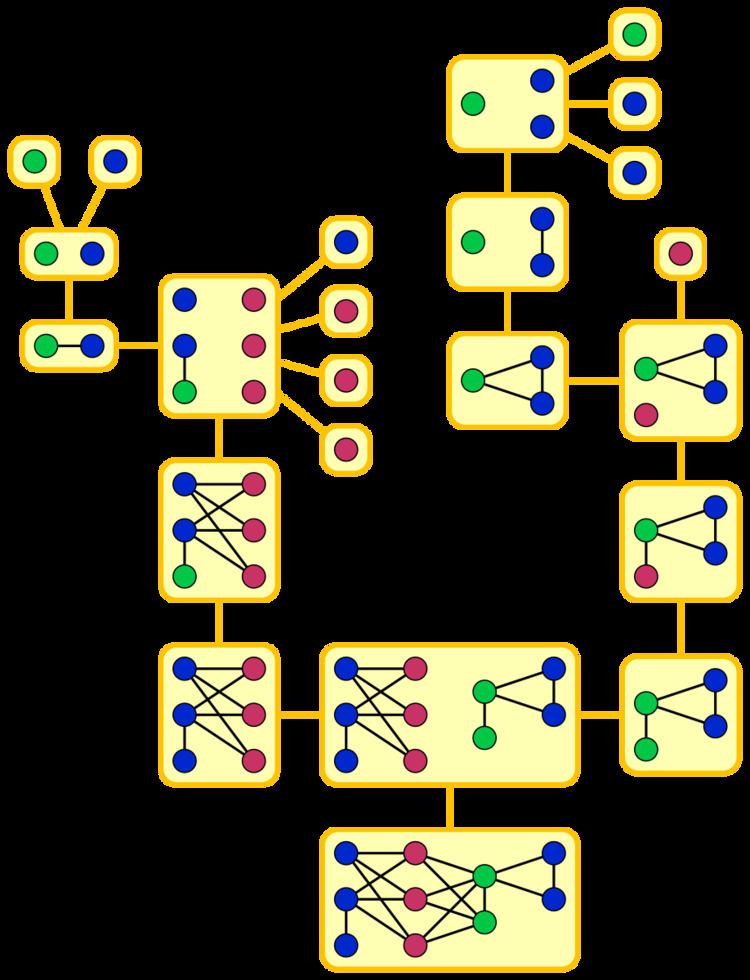 | ||
In graph theory, the clique-width of a graph
Contents
- Creation of a new vertex v with label i ( noted i(v) )
- Disjoint union of two labeled graphs G and H ( denoted
G ⊕ H ) - Joining by an edge every vertex labeled i to every vertex labeled j (denoted η(i,j)), where
i ≠ j - Renaming label i to label j ( denoted ρ(i,j) )
Graphs of bounded clique-width include the cographs and distance-hereditary graphs. Although it is NP-hard to compute the clique-width when it is unbounded, and unknown whether it can be computed in polynomial time when it is bounded, efficient approximation algorithms for the clique-width are known. Based on these algorithms and on Courcelle's theorem, many graph optimization problems that are NP-hard for arbitrary graphs can be solved or approximated quickly on the graphs of bounded clique-width.
The construction sequences underlying the concept of clique-width were formulated by Courcelle, Engelfriet, and Rozenberg in 1990 and by Wanke (1994). The name "clique-width" was used for a different concept by Chlebíková (1992). By 1993, the term already had its present meaning.
Special classes of graphs
Cographs are exactly the graphs with clique-width at most 2. Every distance-hereditary graph has clique-width at most 3. However, the clique-width of unit interval graphs is unbounded (based on their grid structure). Similarly, the clique-width of bipartite permutation graphs is unbounded (based on similar grid structure). Based on the characterization of cographs as the graphs without induced subgraph isomorphic to a chordless path with four vertices, the clique-width of many graph classes defined by forbidden induced subgraphs has been classified.
Other graphs with bounded clique-width include the k-leaf powers for bounded values of k; these are the induced subgraphs of the leaves of a tree T in the graph power Tk. However, leaf powers with unbounded exponents do not have bounded clique-width.
Bounds
Courcelle & Olariu (2000) and Corneil & Rotics (2005) proved the following bounds on the clique-width of certain graphs:
Additionally, if a graph G has clique-width k, then the graph power Gc has clique-width at most 2kck. Although there is an exponential gap in both the bound for clique-width from treewidth and the bound for clique-width of graph powers, these bounds do not compound each other: if a graph G has treewidth w, then Gc has clique-width at most 2(c + 1)w + 1 − 2, only singly exponential in the treewidth.
Computational complexity
Many optimization problems that are NP-hard for more general classes of graphs may be solved efficiently by dynamic programming on graphs of bounded clique-width, when a construction sequence for these graphs is known. In particular, every graph property that can be expressed in MSO1 monadic second-order logic (a form of logic allowing quantification over sets of vertices) has a linear-time algorithm for graphs of bounded clique-width, by a form of Courcelle's theorem. It is also possible to find optimal graph colorings or Hamiltonian cycles for graphs of bounded clique-width in polynomial time, when a construction sequence is known, but the exponent of the polynomial increases with the clique-width, and evidence from computational complexity theory shows that this dependence is likely to be necessary.
The graphs of clique-width three can be recognized, and a construction sequence found for them, in polynomial time using an algorithm based on split decomposition. For graphs of unbounded clique-width, it is NP-hard to compute the clique-width exactly, and also NP-hard to obtain an approximation with sublinear additive error. However, when the clique-width is bounded, it is possible to obtain a construction sequence of bounded width (exponentially larger than the actual clique-width) in polynomial time. It remains open whether the exact clique-width, or a tighter approximation to it, can be calculated in fixed-parameter tractable time, whether it can be calculated in polynomial time for every fixed bound on the clique-width, or even whether the graphs of clique-width four can be recognized in polynomial time.
Relation to treewidth
The theory of graphs of bounded clique-width resembles that for graphs of bounded treewidth, but unlike treewidth allows for dense graphs. If a family of graphs has bounded clique-width, then either it has bounded treewidth or every complete bipartite graph is a subgraph of a graph in the family. Treewidth and clique-width are also connected through the theory of line graphs: a family of graphs has bounded treewidth if and only if their line graphs have bounded clique-width.
